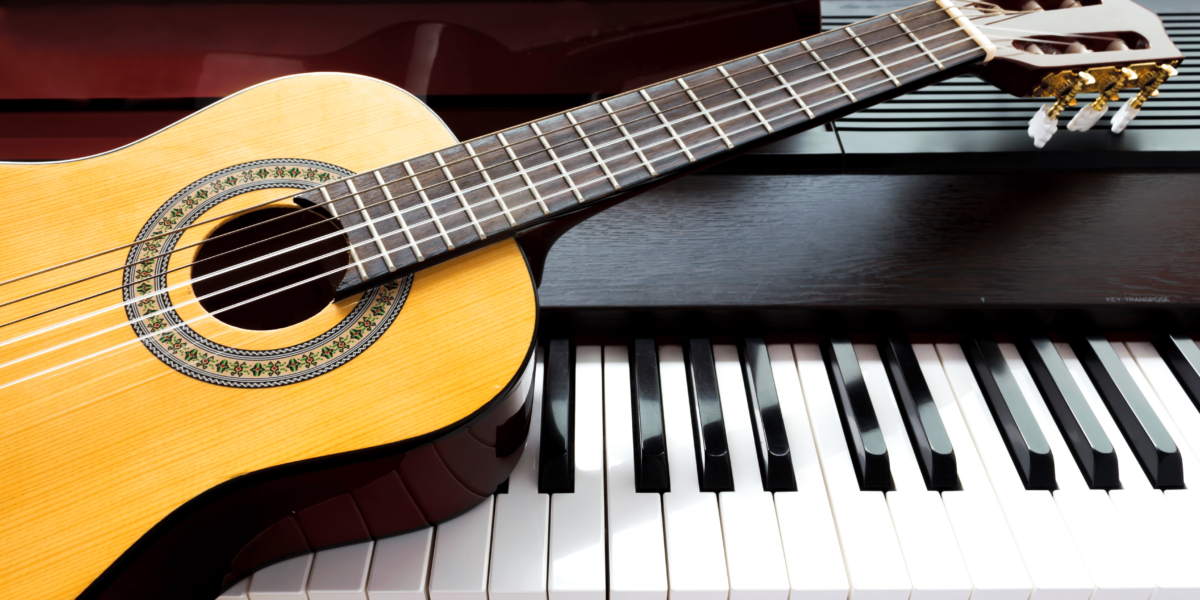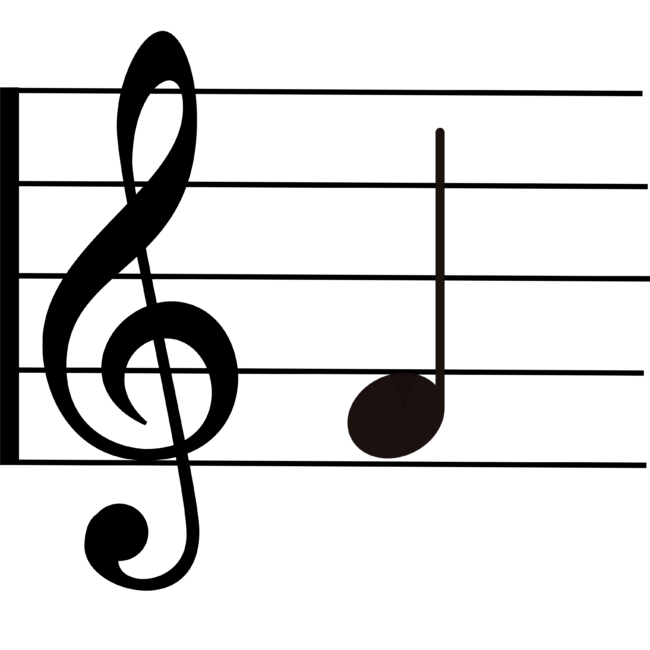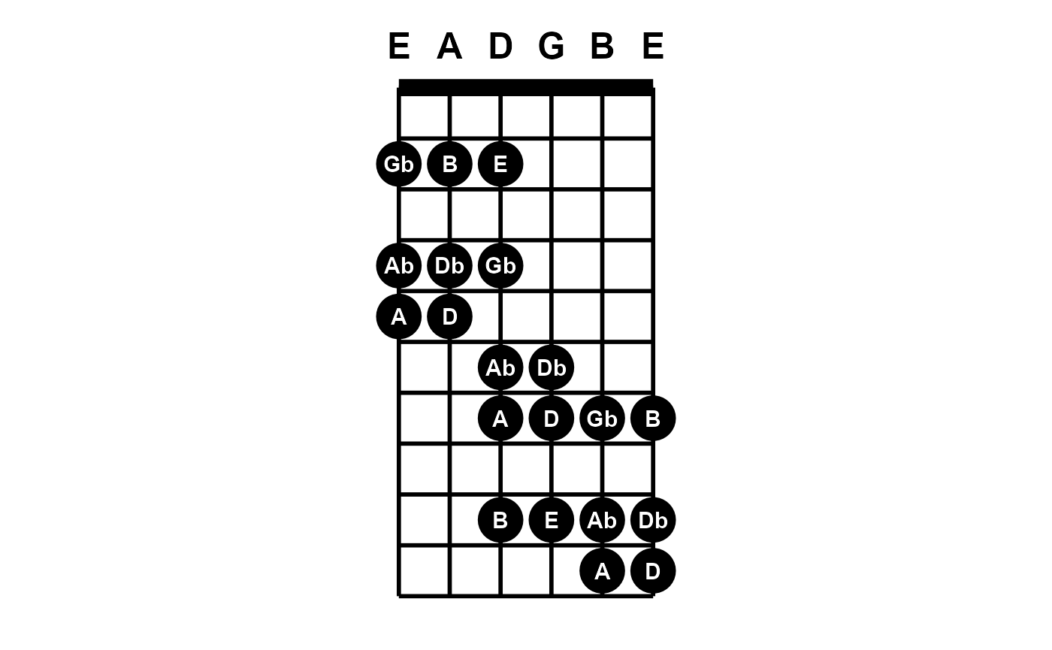How to Play Guitar Chords on Piano

Are guitar and piano chords the same? Is it possible to convert guitar chords into piano chords? Get the low down on everything you need to know in this article.
Guitar and piano are an eclectic pair. There are lots of things they have in common, but also lots of different qualities.
They are both chordal instruments, making them ideal for accompanying vocals. This means that guitarists and pianists are both usually harmony leads and use various combinations of notes to create fancy chords.
And yet, the layout of the instruments is different. This, of course, requires different techniques for playing.
In this article, we dive into the similarities and differences between chords on the guitar and piano.
Are guitar and piano the same chords the same?
Playing chords on the guitar is a lot about learning, memorizing, and practicing hand shapes, which you use and adapt to make all sorts of chords. This is because the fretboard has the notes stacked in columns and rows.
As the guitarists develop, they can start to crack open the shapes and play variations.
The piano player may use shapes in the beginning stages but quickly becomes more freestyle. The piano keys are in one long row, with all the notes in front of you. This makes it easier to break out of the patterns and explore different note combinations.
For example, some weird, dissonant jazz chords would be almost impossible to recreate on the guitar. On the other hand, you can configure nearly every guitar chord on the piano.
The downside to this range of freedom is that pianists tend to overcomplicate things. There is casual magic strumming on a guitar that the piano cannot replicate!
Do guitar and piano chords sound the same?
You could say that guitar and piano share a grandfather. Or maybe a great-grandfather. Either way, they both descend from the string family. In both instruments, the strings create the resonance of pitch.
One major difference is that guitar players directly interact with the strings. They press them down on the fretboard to choose the pitches, then pluck and strum away on the other end.
Piano players have to go through two more messengers — the key and the hammer. You press the key, which makes the hammer bend, and hit the string, which produces the sound.
These technical differences in function create unique sounds for each instrument. Both have a range of gentleness and power.
The sound of a guitarist plucking strings has a vulnerability that a piano player can never achieve because the piano’s inherent precision – the hammer – always hits each note on the head.
True, the guitarist can strum like crazy on the strings, but the piano has strength and resonance, especially in the low-end pitch that the guitar wasn’t built to produce.
For this reason, the guitar and the piano tend to float towards different genres.
The piano is prominent in the more refined arts like classical music and jazz. On the other hand, the guitar is very much the heart and soul of folk and country music.
There are endless exceptions to these rules. Some of the most successful musicians of the last centuries were those who found creative ways to innovate and re-contextualize the use of both instruments.
How to convert guitar chords to piano chords.
If you’re learning guitar, your teacher or online learning app has probably taught you a series of hand shapes. For example, the same shape is used to play a D major chord and an E major chord; Em uses the same shape as Asus2.
If you want to figure out these chords on piano, you should play them first on guitar. Pluck each string individually, and see if you can match it up with the keys on the piano, one note at a time. You’ll notice that a guitar chord often has more than one of the same note.
The truth is, you wouldn’t necessarily play E minor like this on the piano. Because of the piano’s very clear layout, you technically could recreate this exact chord, but it would have a different feeling. If you want to play E minor on piano, you’re better off playing a regular triad in one of its inversions:
Root position: E G B
1st inversion: G B E
2nd inversion: B E G
If you want to fancy it up a little and make it sound like a true piano chord, try adding some jazz-style extensions, like the 7th, 9th, 11th – or all three! We’ve labeled each note with its degree in the E minor scale.
Right hand:
G (3)
A (11)
D (7)
F# (9)
Left hand:
E (1)
B (5)
If you want to read more about Piano Chords for Beginners, check out this article by JoyTunes.
How to read piano notes.
Music for piano is written on a staff. A staff is a stack of five horizontal lines. Each line and each space between them represent a different note. It looks like this:
[insert image of an empty staff]
Before the notes appear on the staff, there are three symbols that you should be familiar with: the clef, the key signature, and the time signature.

Clefs
The clef is a symbol that appears at the beginning of the staff, on the left side. The placement of the notes depends on the clef. There are two main types of clefs: treble and bass.
The treble clef is also called the G clef because the center of the symbol is placed on the second line from the bottom, which is the note G above middle C.
The bass clef is called the F clef because its symbol has two dots on either side of the second line from the top, which is the note F below middle C.
The idea is that the clefs allow the piano player to read music in different piano registers. The bass clef is usually for the lower left-hand part, while the treble tends to appear on the upper staff for the right-hand part.

Key signature
After the clef appears, the key signature. This tells you how many sharps and flats to play in the music. For example, in the key of G, a sharp symbol is written on the F line. Any time an F appears in the music, you should play it as an F#.

Time signature
After the key signature, there’s the time signature. It comprises two numbers. For example, 4/4:
The upper number says how many beats per bar. The lower number says the type of beat. For example, 4/4 means four quarter notes, 6/8 means six eighth notes, and so on.
Note rhythms
Now that all the signatures are out, we can get to the nitty gritty stuff! So what does a note look like? Each note has two components to its appearance – the stem and the head. Both of these communicate the rhythm of the note – how long it should be held. The notes are then divided into bars according to the time signature. Bars are vertical lines that cross the horizontal lines of the staff.
Here is a guide to help you understand notes’ rhythmic values and recognize them when you see them in sheet music.

A note with no stem and no filling is the longest. It’s worth four beats. It’s called a whole note.

A note with a stem but no filling is worth two beats and is called a half note.

A note with a filling and a stem is worth one beat. It’s called a quarter note.

A note with a filling, a stem, and a tail is called an eighth note. It’s worth half a beat.

A note with a filling, a stem, and two tails is called a sixteenth note, worth a quarter of a beat.
How to read guitar fretboards.
Notation for guitar fretboards is often called guitar tabs.
Fretboard notation looks exactly like the fretboard itself (if you hold the guitar in front of you with the neck up).
It is a grid with seven vertical lines representing the five strings. It has anywhere between five and twelve horizontal lines, depending on the musical range of the music you’re reading.

Like on the piano staff, the notes appear as small black dots. The piano staff has notes on both lines and spaces, but the guitar fretboard only places notes on the lines where the fingers press the strings. Like this:
Each box of the grid represents another semitone. The pitch becomes higher as you play further towards the guitar’s body.
As you probably know, guitarists have two separate actions (with two different hands) for playing their instrument. The left hand presses down on the fretboard, which chooses the pitches, while the right hand strums or picks the string to produce the sound.
Guitar tabs don’t communicate the rhythm that the guitar should play – just the chords and notes. For this, the person who writes the tab usually includes the time signature and the feel at the top of the tab. For example, “4/4, Funky strumming pattern”; or “ 6/8, Folky picking pattern”.
Apples and oranges.
Some would say that you can’t compare piano and guitar. They’re such different creatures. Indeed, knowing one doesn’t make you an expert at the other. But there is a lot of overlap. If you’ve already got one instrument down comfortably, don’t be afraid to use your knowledge and experience with one to learn about the other. Before you know it you’ll be doing a Jacob Collier cover show where you play everything on your own!
Another overlap with these two instruments is that the Simply Piano app teaches guitar and piano. Try it today.









